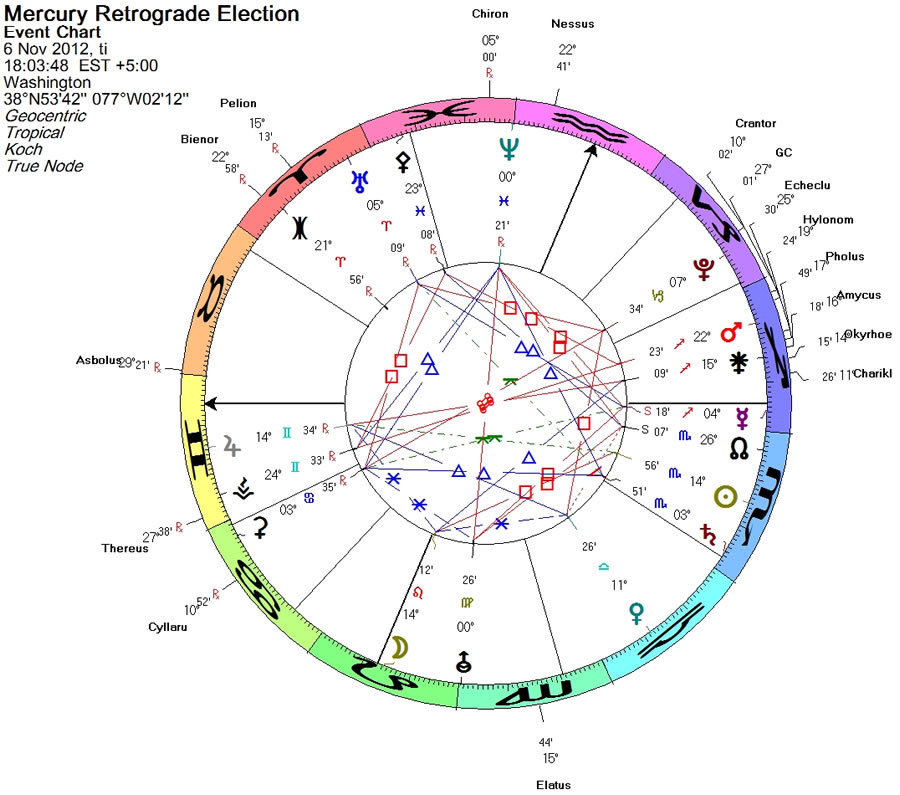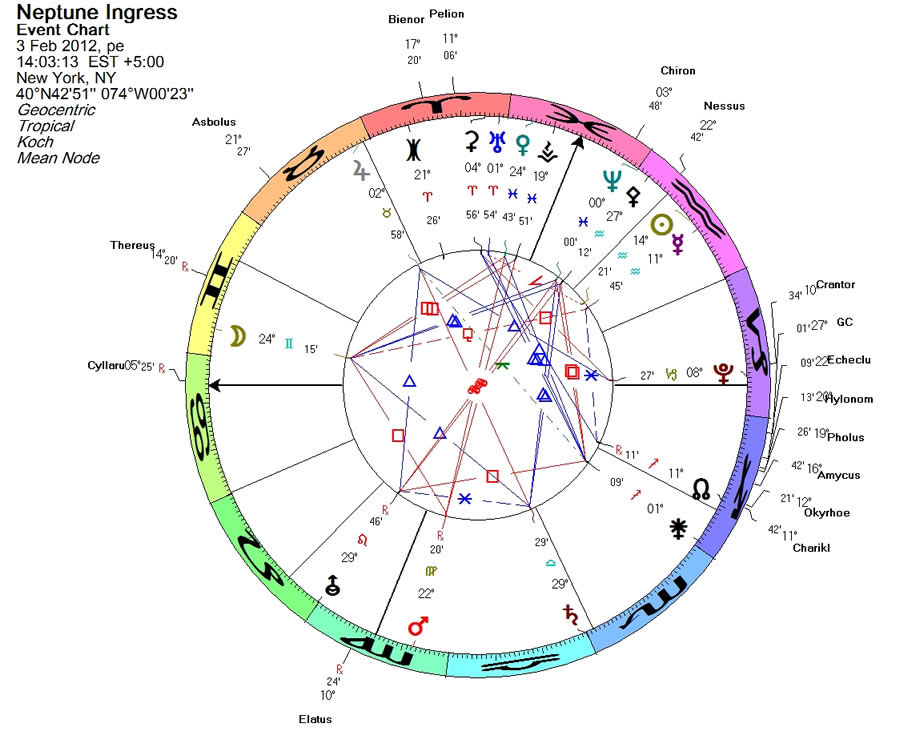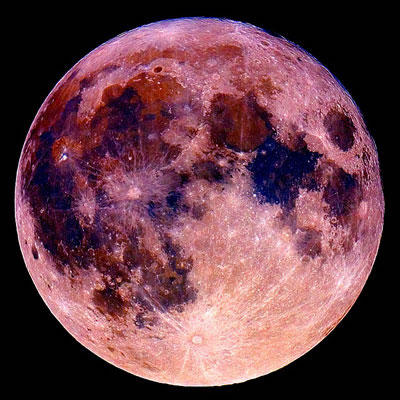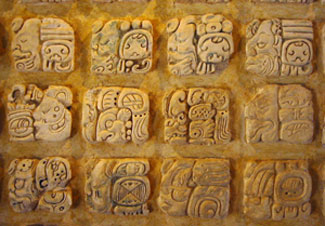Navigate Signs:
Recent Posts
Archives
Featured links:
Author Archives: Eric Francis
Capricorn — When the Moon is in the First House
That is the name of the Capricorn essay for Reality Check. I began with an unusual series of events that happen in Capricorn which I have not mentioned elsewhere, or maybe just once. I don’t recall where. In 2012, every time the Moon makes a conjunction to Pluto, it’s an occultation — it blocks Pluto entirely. This happens 19 times between April 2012 and August 2013, every time the Moon goes past Pluto. This has not happened since Pluto was in Cancer (near its discovery degree) in the 1930s. There are 29 eclipse-like events in 2012, as compared to just nine in 2011. Anyway it’s a fun piece and I am looking forward to seeing it on the page.
Posted in 2012 Diary
Leave a comment
Onward into Capricorn
I am about to begin writing Capricorn’s interpretation. As mentioned, the audio has been finished for a while, and it’s prepared and ready — as soon as the written interpretations are done and edited. Going at the rate of one written interpretation per day — that’s about all I can handle — with any luck at all, I will finish the signs on Saturday with Pisces.
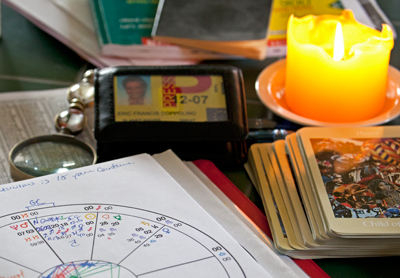
My kitchen table desk, where I have written and recorded nearly all of Revolution. Revelation. Reality Check. Those are the Voyager tarot cards to the right, and to the top left is Raphael's Ephemeris, the one used (and published) by the Brits. Photo by Eric.
Then I’ve reserved two days to rewrite and edit. As far as I am concerned, once this astrology enters someone’s mind, there is no taking it back — so I try to get it right. Another astrologer is also going to read through the signs, to provide a layer of technical editing, to make sure the basic references are correct.
The audio presentations are in three sections; I also recorded a series of 12 practice runs using a special technique involving the minor planets, that I then put on my iPod and took notes from; these notes are feeding the written interpretations. I am reversing the order of my work — forward, backward (through the three audio readings) and then forward again (for the written readings) as there is a distinct energy shift depending on which way the astrologer treads the wheel.
Looking into my notebook, the Capricorn reading will include a discussion of how to handle Pluto going through this sign. There is something about listening to children as a source of wisdom. And there is a question, “Who tells the story of your life?” I may be telling the story of your astrology, but you definitely tell the story of your life.
Note, I will do a separate Capricorn birthday report, but that will be after I move this whole flea circus along.
Posted in 2012 Diary
Leave a comment
The Long and Short of the Mayan Calendar
By Bruce Scofield
The “Mayan Calendar” is the popular name for the 5,125-year organization of time, number, astrology, and astronomy employed by the Maya in ancient Mesoamerica. Archaeologists and historians of Mesoamerican civilization generally refer to this symbolic time grid as the Long Count. The Long Count has three elements that are shared with the Western calendar (which governs daily life in the first world): a means of grouping large periods of time, a base date, and an astrological component.
Time
We use natural astronomical motions to organize time in order to coordinate social activities. From the counting of Moons in the Paleolithic to the modern definition of the second by fractioning the Earth’s orbit around the Sun, astronomy has been the backbone of our calendars and time-keeping systems. In the Western calendar, time is grouped into solar years, decades, centuries, and millennia. We organize time according to the solar year in multiples of the number 10, a good number to use if one counts on fingers. In the Long Count time is grouped into multiples of the numbers 20 (fingers and toes) and also 13, numbers that Westerners are less familiar with. In the Western calendar, time is linear. There’s a starting point, 0, and straight lines move forward and backward in time from that point. Significance is thought to occur when a multiple of ten is crossed, like the year 2000. Western time only moves forward, but in the Long Count, time is both forward and cyclic.
The starting point of the Long Count is August 11, 3114 BCE and the end date is December 21, 2012, a span of 5,125.37 years or exactly 1,872,000 days. There are therefore a finite number of days that must occur between the base date and the end date, and these days are grouped in several blocks of time that cycle simultaneously. One fundamental time unit used by the Maya, called a tun, measures 360 days and approximates the solar year. 5,200 tuns make up the Long Count. Another fundamental time unit is the katun, a period equal to 20 tuns (20 x 360 ~ 7,200 days or 19.71 years). Interestingly, a katun is very close (within 54 days) to the mean synodic cycle of Jupiter and Saturn which is 19.86 years. It is very probable that the katun represents in a numerologically ideal form the Jupiter/Saturn synodic cycle – similar to the rounding off of the 365.24 days of the year to 360 degrees of the zodiac. The Maya regarded the katun of 7,200 days as a major historic time period, a generation marker of sorts. There are 260 katuns in the Long Count as 20 x 260 ~ 1,872,000 days. The baktun, a period of 144,000 days or 394 years, subsumes 20 katuns and there are exactly 13 baktuns in the Long Count. Because each baktun contains 20 katuns, it too is related to the cycle of Jupiter and Saturn conjunctions.
1 solar year = 365.24 days
1 tun = 360 days = 0.99 years
1 Jupiter/Saturn conjunction = 19.86 years
1 katurn = 20 tun = 19.71 years
20 Jupiter/Saturn conjunctions = 397 years
1 baktun = 20 katuns = 394 years
Okay, let’s review. The Long Count is a 5,125-year span that is composed of 5,200 tuns (360 days), 260 katuns (7,200 days), and 13 baktuns (144,000 days). Just about all you need to know about Maya time and number is contained in these figures.
Now some of you may know that the Maya, Aztecs, Toltecs and nearly every distinct culture that lived in Mesoamerican (ancient Mexico and northern Central America) used a count of 260 days that forms the core of a unique astrological system. You may also know about a 20-day sequence of signs, called day-signs, that make up the 260-day count and function like a zodiac. This eternally repeating sequence of 260 days is called the tzolkin and it is composed of 13 repeats of the 20 day-signs (13 x 20 ~ 260).
Archeologists call this 260-day count the divinatory calendar, or the sacred calendar, because it was, and still is, also used as a divination device. In my writings, I have called it an astrological calendar for several reasons. First, the twenty signs function like a zodiac – they symbolize an evolutionary sequence. Second, these day-signs appear to be imprinted on a person at birth. Trained professionals in ancient times used it to evaluate personality and destiny and even today, Maya shamanic daykeepers use it for the same purposes. A third reason is that it resonates strongly with certain astronomical cycles.
Consider the following:
1. Venus’ appearance interval as a morning star or evening star = 263 days.
2. Nine 29-day synodic cycles of the Moon = 261 days.
3. The interval from one eclipse period to another (the time it takes the Sun to move from one lunar node to another) = 173.3 days. This is called the eclipse half year. Three of these = 520 days, or 2 x 260.
4. The synodic cycle of Mars is 780 days. One third of this figure = 260 days.
5. Twenty synodic cycles of Mercury (about 117 days), four synodic cycles of Venus (584 days) and three synodic cycles of Mars (780 days) are equivalent to nine cycles of 260 days.
The 260-day count seems to incorporate real sky rhythms and will therefore be synchronized to a large degree with certain aspects of the changing sky. Finally, it should be said that the native Maya believe that 260 days is the time of human gestation, and that the conception day-sign and the birth day-sign should be the same.
Now remember that there are 260 katuns in the Long Count. Consider that the day unit of the 260-day astrological calendar can be equated with the katun unit of the Long Count and the tzolkin is a fractal of the Long Count. If the tzolkin is astrological, then is that property true of the Long Count? That’s something I have addressed in other writings and will touch on in this one.(1) But first a few more basics so that we can sort our way through the maze of numbers, symbols, fantastic visions and apocalyptic imagery ahead of us.
Precession
The Long Count as a time-structure defines a 5,125-year period that contains most of human oral and written history. In fact, ancient history nearly everywhere starts around 3,000 BCE. This was the time of the building of the first Egyptian pyramids and the establishment of the Old Kingdom, the first writing in Sumeria, and the first structures at Stonehenge were put into place. The Hindu Kali Yuga begins at this time as well. Because of this coincidence, many have argued that the Mayan Calendar maps out the evolution of human consciousness. More on this later. For now, however, I want to direct your attention to the fact that this 5,125-year period is only one fifth of a much larger cycle, the cycle of the precession of the equinoxes.
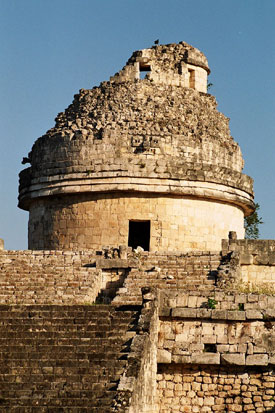
Mayan astronomers used observatories such as this one, located in the ancient city of Chichén Itzá. Windows at the top level, now partially destroyed, were strategically placed to observe the positions of sunrise and sunset and the motions of the Moon and Venus. Photo by Bruno Girin from Wikimedia.
As the Earth orbits the Sun, it rotates on its axis 365.24 times. At the same time, the Earth’s axis is wobbling (like a top) in such a way that if you extended it into space it would describe a cone over the course of about 25,770 years.
This wobbling also translates into the movement of the equinoxes, the points where the Earth’s extended equator intersects the Earth’s orbital plane. The equinoxes move backwards against the constellations at a rate of about 1 degree every 72 years.
This changes the stellar background of the tropical zodiac signs over time and is the basis of the differences between the tropical and sidereal zodiac. If we take the mean precession cycle of 25,770 years and divide it by 12 we get astrological ages of about 2,148 years. This is one of Western astrology’s ways of delineating long periods of historical time. Today we are presumably in the age of Pisces, but near to the age of Aquarius.(2)
Now if we take the mean precession cycle of 25,770 years and divide it by 5 we get 5,154 years. This figure is remarkably close to the 5,125-year span of the Long Count. Considering the fact that the figure given for precession is a mean figure and that the actual value may vary by two or three hundred years, I’d say this was an extremely accurate reading of this astronomical motion by the Maya. It is much closer than the figures given by Plato and those encoded in the Great Pyramid.(3) Both Maya and Aztec cosmology tell of five great ages, the present age being the fifth. Further, the Maya had time periods much larger than the Long Count itself, extending time far beyond where it was taken by ancient Western cultures. This information suggests that the Long Count is a one-fifth segment of the precession cycle and that Maya time existed before 3114 BCE and will exist after 2012. It seems reasonable then to regard the beginning and ending of the Long Count as transition points of the larger precession cycle and not absolute originations or terminations.
Given the simple technology available to them, the ancient Mesoamerican astronomers did some amazing work. Not only did they measure the length of the precession cycle, but they also anchored it with a remarkable alignment, the meeting of the winter solstice Sun (not the vernal equinox which is used in Western astrology) with the galaxy itself, the band of the Milky Way. Since our galaxy is shaped like a disk, we can draw an equator-like plane through the Milky Way and mark where it intersects the ecliptic, the plane of the Earth’s orbit around the Sun. (see diagram)
Although academic researchers had studied the Long Count for decades, they were not, to my knowledge, the first to recognize its linkages with the precessional cycle and the alignment with the center of our galaxy. They did, however, recognize that Maya cosmology was very night-sky oriented and that the Milky Way, specifically the dark band that runs inside it in the vicinity of the ecliptic, figured prominently in their mythology. In the late 1980s and early 1990s, a few astrology-friendly independent writers and researchers, including Ray Mardyks and John Major Jenkins, were the first to suggest that the Long Count was more than simply a long string of numbers, it marked the precession of the winter solstice Sun over the galactic equator. It now appears that the Maya, or possibly their predecessors, calculated in advance when the winter solstice point would pass through the dark band in the Milky Way, in 2012, and then projected the Long Count backwards, arriving at its base date in 3114 B.C. Jenkins, whose writings on this subject are highly recommended, makes a good case for this calculation having occurred in Izapa, a very ancient city near the Pacific coast at the Mexican/Guatemalan border.(4)
The Base Date and the Calendar Correlation Problem
The 260-day astrological calendar in Mesoamerica originated as far back as possibly 2,500 years ago. It is thought that the Long Count of the Maya originated perhaps 500 years later. Both counts appear to have run continuously without interruption since their beginnings. In order for us to know when a particular day arrives, whether it be in the 260-day count or the Long Count, we must have a method of correlating it with the Western calendar.
The base date of the Western calendar is the year that Jesus of Nazareth was supposedly born. Everything in Western history is dated relative to that point, either before (B.C.E.) or after (A.C.E.). In some cases, researchers use a minus (-) sign to refer to B.C. dates. (There is no zero year. Year 1 stands but a day apart from year -1). Historians and astronomers have also numbered the days, as far back as several millennia before the Common Era, each day having its own unique Julian number, as they are called. One way of correlating the 260-day astrological calendar or the Long Count with the civil calendar is to link it to a Julian date. If we know the Julian date of an event, and we have our calendars linked to this system, then we can move dates back and forth between calendars.
For nearly a century researchers struggled with the precise location in time of the Long Count’s base date. During the 1970s and ’80s, a majority of investigators in several fields came to accept a correlation that is supported by many facts known as the Goodman-Martinez-Thompson correlation, the G.M. T. It is named for the three men who settled on the same Julian date number for the base date of the Long Count – Julian day #584,283. This correlation is backed up by ancient stone inscriptions, historical records, astronomical data, and the oral tradition of the most conservative Maya in Guatemala. Today, nearly all researchers have accepted Julian Day #584,283 – which corresponds to August 11, 3114 B.C.E – to be the base date for the Long Count.(5)
Despite the acceptance of this established date, many people have been misled in regard to the timing of the 260-day calendar and the Long Count. The artist and writer Jose Arguelles, one of the people behind the Harmonic Convergence of 1987 and the man who invented Dreamspell, an oracular game based on the Mayan calendar, has promoted some very questionable ideas about this aspect of Maya culture. Arguelles is a graphic artist and master of tech-speak, but he is no astrologer and is certainly not particularly sensitive to the facts about the Long Count. In his 1987 book The Mayan Factor, Arguelles explained his belief that the Mayan Calendar is a kind of holographic code that times the passage of Earth with its human passengers through a beam emanating from the galactic center. This galactic synchronization will then mark a transition point in the evolution of consciousness and usher in a new Solar Age. While this is an intriguing idea, it is far from factual – it is mostly a fantastic product of the imagination. His calendar correlation, which has led to much confusion on this issue, does not fit with the known facts. Jose Arguelles and the followers of his writings and his product Dreamspell use a correlation that now differs from the G.M.T. correlation by seven weeks. Between 2004 and 2008 it will differ by one day less because it ignores leap years and thus loses one day every four years. Every day counted to the ancient Maya, no days were ever dropped.
Astrology
While the Western calendar is anchored to the year that Jesus was allegedly born, it contains a week of seven days that are named for planets. This seven-day week, a quarter of the lunar cycle, is actually an astrological remnant of the pre-Christian Near East. The day itself and also the planetary hours (divisions of the day) are thought to have an astrological quality. Seven planetary rulerships cycle over each 24-hour period and the hour that begins each day at dawn gives its name to that day. At various times in the history of Western astrology, the planetary hours were used in the search for propitious times, to read the destiny of a newborn, and to evaluate the nature of the new year itself. The planetary hours are a remnant of a kind of astrology that uses blocks of time as “signs,” very much like the Mesoamerican day-signs, though in a 7-day framework.(6) In contrast, nearly all of Western astrology since the Greeks uses blocks of space which hold symbolic meaning, i.e. signs, houses, and aspects. The Mesoamerican astrological tradition is built on a structure of blocks of time, which function like the spatial signs of Western astrology.
The Long Count’s divisions into 260 katuns and 13 baktuns are blocks of time that one would expect to have some kind of astrological value since they resonate with the Jupiter/Saturn cycle. Given that Western astrology, and probably Chinese astrology as well, used these planets are primary markers of historical change, it seems logical that the Long Count could also function as an accurate time-grid.(7) But would-be historians, be warned. Finding events to match the divisions of the Long Count is very different from arriving at a deep understanding of history and then attempting to perceive a pattern. For example, the last baktun of the Long Count began in 1618. Certain authors have pointed to that time as the beginning of materialistic science, and it is true that the scientific revolution was in full swing then.(8) But most historians see the scientific revolution as a process that began decades earlier, and some even place it in the late Middle Ages.
The baktun appears to be a reasonably good historical marker, but Western astrology has plenty of methodology that draws similar grids over history. The Great Mutation Cycle of Jupiter and Saturn, about 800 years (794 to be exact) marks the shifting of Jupiter/Saturn conjunctions into Fire signs. It has been one of the premier astrological chronocrators (along with the precession of signs at the equinox and the saros cycle of eclipses) of human and Earth history. The last Great Mutation occurred in 1603 and Johannes Kepler himself wondered, knowing that 800 years earlier Charlemagne restored the Holy Roman Empire and 800 years before that Christ walked the Earth, what kind of new age it would bring. My point is simply that some New Age writers on the Mayan Calendar are touting it as far superior to Western astrology, without knowing very much at all about our subject. Further, these writers are often somewhat disparaging of Western astrology, treating it like it has nothing of consequence to offer in regard to understanding world history, or even the evolution of consciousness.(9) I want to point out that many writers on the Mayan Calendar are clueless when it comes to the larger body of astrological tradition, which is kept alive and developed further in the NCGR curriculum, Kepler College and many astrological organizations. That being said, there is a lot to commend the time-frames built by the Maya.
I have argued that the cornerstone of Mesoamerican astrology is the 260-day astrological calendar. The Long Count, with its 260 katuns, appears to be simply a large-scale, mundane version of the 260-day astrological count. The 13 baktuns mark off historic time as listed below, each one containing 20 katuns which could each be interpreted as a day-sign. Think also of the baktun as a round-figure approximation of 20 Jupiter/Saturn conjunctions. Each of the 20 katuns contained in a baktun doesn’t necessarily begin or end with a conjunction, but it is so close to the period that it retains the form of the wave over a long period of time, regardless of its starting point.(10)
Baktun 1 – 3114 BCE to 2720
Baktun 2 – 2720 to 2325
Baktun 3 – 2325 to 1931
Baktun 4 – 1931 to 1537
Baktun 5 – 1537 to 1143
Baktun 6 – 1143 to 748
Baktun 7 – 748 to 354
Baktun 8 – 354 to 40 ACE
Baktun 9 – 40 to 434
Baktun 10 – 434 to 829
Baktun 11 – 829 to 1223
Baktun 12 – 1223 to 1617
Baktun 13 – 1617 to 2012
The Long Count is a sequence of 13 baktuns containing 20 katuns each. The last katun of each baktun corresponds to the last day-sign of the 20-day count, and the last katun in the entire Long Count could be seen as corresponding with the last day of the entire 260-day astrological calendar – which is the day 13-Ahau. This opens up a possible avenue of interpretation, presuming one has a solid understanding of the day-signs and the tzolkin. But there is another way of organizing the katuns in the Long Count. We know for sure that the Maya also counted katuns in groups of 13, a period of 256 years sometimes called the Short Count.(11) This cycle length has astronomical counterparts. For example, 13 mean Jupiter/Saturn conjunctions is 258 years, and twice the mean Pluto/Uranus cycle is 255 years. Does this make this cycle astrological? Astrologers know that Pluto/Uranus conjunctions pack a big punch and given this cycle length, these conjunctions will occur in the same section of the length repeatedly. In a few places I’ve suggested that this katun cycle was the real Maya prophecy cycle and that it appears to correlate to some extent with historical events, but this could just as well be attributed to the Jupiter/Saturn cycle.(12) We are presently in the last katun of the entire Long Count, which is also the last katun of the Short Count and it correlates with the last day-sign (Ahau) of the last trecena (1-Lamat).
There is no reason why the sequence of katuns should end in 2012. However, the katun that begins in 2112 and ends in 2132 will correspond with the first day of the 260-day count, the day-sign 1-Imix. Although the 260-day calendar is thought to be a continuous process that can begin at any point within it, 1-Imix is considered the starting point, the point of initiation. Imix, the sign of creation, symbolizes the crack in the cosmic egg, the bursting forth of energy moving from one world to another, and the generative and creative forces that rule the Earth. The sign is also concerned with nourishment and sustenance and it suggests the need to care for our offspring and our surroundings – our lives depend on our relationship to our environment. Given the fact that the world is already overpopulated and running out of resources, this symbolism seems quite apt.
The end date of the Long Count is both the terminal point of the current fifth part of the precessional cycle and, in the context of the Mesoamerican 5-stage creation cosmology, the terminal point of the entire 25,770-year cycle itself. Like the millennium a few years ago, prognostications abound as to what will happen. I don’t think this time passage marks the end of days. The truth is that December 21, 2012, marks the beginning of a new phase in the precession of the winter solstice – but only if you accept that the dark band in the Milky Way constitutes the most important anchor point in the entire cycle. If you are looking for the point when the solstice point aligns exactly with the galactic equatorial plane itself, then look behind you. This alignment occurred during 1998.
As the position of the winter solstice Sun moves backwards along the ecliptic, it crosses the line defining the galactic equator over the course of about 36 years. This is because the disk of the Sun measures about one half degree of longitude and, given the rate of precession of about 1 degree per 72 years, some part of the Sun will cover this node for half that time. So the solstice Sun’s initial and final contact points are actually around 1980 and 2116, and because the angle of intersection of the ecliptic and galactic equator is about 61 degrees, this extends the period of solar contact with the equator by about another 5 years on each side. So, truth be told, the exact alignment has already occurred. Were the Maya wrong?
The Maya were more concerned with the passage of the solstice Sun through the dark band in the Milky Way, clearly visible on a clear night far away from light pollution. In their cosmology, this dark band was the origin point of the creation, the pathway to the gods who dwelled in the underworld called Xibalba. Contact of the solstice Sun with this point would seem extremely signficant given their cosmology and mythololgy. And it turns out that their calculations were fairly accurate, so the “end date” still stands. But what does it all mean?
Here we enter Mayan Calendar central, literally and figuratively. First, keep in mind that the academic researchers (archeologists, archeoastronomers, ethnoastronomers, etc.) have nothing to say about this matter. They will only point out that the Long Count reaches completion at this time and that the next cycle then begins, after all the Maya did have longer periods than the Long Count so they must have expected time to continue. The indigenous people, however, dropped the Long Count long ago so we don’t have a solid oral tradition on this topic. Some indigenous Maya have issued prophecies of end times, but these may not be Long Count prophecies, and it is probable that some of these have been influenced by American New Age interpretations of their ancestors’ calendar. This lack of and possible distortion of a native tradition has left the barn door open to interpretations that are based totally on beliefs. For example, if you believe that there is a divine plan behind the evolution of consciousness, then you could see the Mayan Calendar as a time grid that reveals the intelligent process of creation that is making the world we experience. In other words, the Long Count is evidence of intelligent design and also a means by which humans can attune themselves to the cosmic junction just ahead of us in 2012. One could say the same thing about Western or Hindu astrology. And this is only the beginning for wild interpretations of the Long Count. We can be free to imagine that the alignment of the solstice Sun with either the galactic equator (which has already happened), the galactic center (which won’t ever happen but it will be closest to in a couple of centuries) or the dark band of the Road to Xibalba (which does happen around 2012), will trigger a major event.(13) Maybe it will unleash a galactic beam of consciousness from the center of the galaxy directly to us humans on Earth, and somehow lead us to join the space brothers in a new world of evolved consciousness and interstellar peace. And there are many, many variations of this sort with astonishing details to be found in the steadily growing literature of the Mayan Calendar.
There are a few more points I want to make before I stop squashing fantasies. Many of the writers on this subject tend to talk about the Mayan Calendar, but base much of their rationalizations on what we know from the Aztecs. So it’s not just the Mayan Calendar, but more a kind of Mesoamerican cosmology that is used as the seed point of the visionary improvisations I’m being critical of. Second, astrologers take notice. These writers typically dump on Western astrology. They hesitate to actually identify the Mayan Calendar as an astrological system, but that’s a conclusion that is hard to avoid. Are not astronomically-based time periods that have symbolic meaning a kind of astrology? Let’s call a spade a spade. So ultimately, these people are actually promoting a kind of astrological hierarchy, with the Mayan Calendar at the top because it promotes the “evolution of consciousness” and Western astrology at the bottom because it is materialistic and based on the wrong numerology.
Third, these writers find what they want to find in history and make it fit their scheme. While many Western astrologers are guilty of this, those force-fitting the Mayan Calendar into the very-difficult-to-resolve pulses of European history are stepping into territory that is over their heads – doing history is as complicated as doing astrology. Fourth, ideas of a golden age, end times and transcendent utopias are all part of a phenomenon called milleniumism, or millieniarianism. This bizarre social pathology has been going on for, as it turns out, millenia. Humans, driven by religious beliefs, go nuts when calendars cross boundaries. Let’s be real, most of the New Age literature on the Mayan Calendar falls into this category and, to my mind, is a manifestation of a much larger frustration with the way society is going. But it is all very idealistic and so fantastic that it could be described as a benign (so far) delusion. What we don’t hear about in these accounts are the real problems humans are facing – global cooperation, population pressure, and environmental destruction. These are the issues that underlie nearly all the problems we face. The end-date of the Mayan Calendar won’t save us any more than will the second coming of Jesus. We have big problems to solve right now. Let’s get on with it the best way each and every one of us can.
Don’t get me wrong. I’m not saying that the Long Count is just another calendar. I am saying that it is a remarkable creation of Maya culture and that it is also a kind of astrology that offers another way of measuring symbolic time. Some of its parameters are intriguing, especially its origin date around 3,100 BCE, without a doubt a most important time in history. Also intriguing is the midpoint of the Long Count at 551 BCE, about the time when Pythagoras, Buddha, Lao Tzu and many other wise men lived. Again, it is indeed possible that the Long Count describes history with some degree of accuracy because it resonates with the Jupiter/Saturn cycle of conjunctions, which other astrologically-minded cultures also thought was the key to long-term time analysis. The ending of the Long Count close to the passage of the winter solstice over the galactic equator is also interesting and evidence that the Maya were excellent astronomers.
So it is possible that the Long Count is symbolically descriptive of the passage of waves of time of varying lengths in some ways and I would encourage historically-minded people to take a closer look. But so are cycles of the outer planets. Both are starting points for a time analysis of history. Is the Maya way better than the Western way? It may be so for those seeking to build an identity around a culture that is not theirs and has little power to challenge them. And that’s what all this Mayan Calendar visionary excess is about – a need for identity, a need for answers, and a need to believe that things will get better. If we only wish hard enough. Still, anyone paying attention to the world these days will know that we are racing at high speeds toward a wall. Whether it be 2012 or 2036 or any other date in the next 50 years for that matter, the shit will hit the fan. Our consciousness will absolutely have to change, and guess what? It will have to change by admitting to ourselves that we humans are soiling our nest. We have become self-absorbed lemmings dumping our garbage on billions of other life forms that are supporting our existence. We absolutely must make a shift from a linear, short-term profit kind of thinking to a non-linear grasp of our interconnectedness with our environment. In my view, the “transformation of consciousness” is about humans stopping to define everything in terms of humanness, and that’s not so easy because we just love ourselves so much that nothing else seems to exist. Just watch television and you’ll see what I mean. So the Maya may have managed to nail, more or less, perhaps the greatest wake-up call for humanity since the beginning of the previous glacial period. Pretty impressive.
Footnotes
1. See Scofield, Bruce. Signs of Time. Amherst, MA: One Reed Publications. 1994., especially Chapter 7 and pp. 163-173.
2. Most Western astrologers use the tropical zodiac which begins at the vernal equinox and is therefore fixed to the seasonal cycle. The zodiac of the constellations is called the sidereal zodiac, and it is used by Western sidereal astrologers and by Hindu astrologers. For more information on this topic see my article in TMA #? See also Rudhyar, Dane. Birth Patterns for a New Humanity: A Study of Astrological Cycles Structuring the Present World Crisis. The Netherlands: Servire-Wassenaar, pp. 1969 and Hand, Robert. Essays on Astrology. Glouster, MA: Para Research. 1982, pp. 147-163.
3. See deVore, Encyclopedia of Astrology. New York: Philosophical Library. 1947. pp. 303-309.
4. An excellent work on the Maya calendrics as a precessional system is Jenkins, John Major. Maya Cosmogenesis 2012. Rochester, VT: Bear & Company, 1998. For those interested in the numerological technicalities of this subject see also Jenkins’ earlier book Tzolkin: Visionary Perspectives and Calendar Studies. Garberville, CA: Borderland Sciences Research Foundation, 1994.
5. The consistency of the Maya inscriptions indicates that the 260-day count was not tampered with. Other calendars were changed, but the count, much like the 7-day planetary week in the West, never skipped a beat. During the Spanish Invasion of Mesoamerica a few writers noted specific dates in the Western calendar and in the native 260-day count. When these are compared with the G.M.T they check out perfectly. Ethnologists studying the Quiche Maya in Guatemala have found that the 260-day count used today matches the G.M.T perfectly also. In other words, the archaeologists, archaeoastronomers, historians, and present-day Quiche Maya all agree on the correlation between the Western calendar and the 260-day astrological calendar, the correlation called the G.M.T. Several other correlations have been proposed. In Linda Schele’s books (eg. Linda Schele, David Freidel, and Joy Parker’s Maya Cosmos: Three Thousand Years on the Shaman’s Path, New York: William Morrow and Company, 1993) a correlation proposed by Floyd Loundsbury that differs from the generally accepted G.M.T by 2 days is used.
6. The 7-day week is thought to be an idealization of one-quarter a composite of the sidereal and synodic lunar cycles. There may be a biological foundation for this period length as amplitude cycles in some circadian rhythms display a period length of just under seven days. Woolum JC, Cornelissen G, Halberg F. (2003). Spectral aspects of Acetabularia’s light transmission chronome: effects of enucleation. Neuroendocrinology Letters. 24 (Suppl 1): 212-215.
7. Chinese astrology, which is about as calendrical as Mayan astrology, is based on a cycle of sixty years that is divided into two components: a ten-year cycle of stems and a twelve-year cycle of branches. Six cycles of stems and five of branches is equal to 60 years. Jupiter/Saturn conjunctions have a second order recurrence cycle of 59.58 years and may be the basis of the period length, during which time Saturn makes two cycles and Jupiter five. Jupiter’s twelve-year cycle may be the origin of the branches, and quite possibly the yearly animal zodiac and its five cycles in 60 years is, at the very least, supportive of the five-element theory in Chinese astrology. These relationships appear obvious to me, but they are generally not stated as such in texts on Chinese astrology.
8. See Arguelles, Jose. The Mayan Factor. Santa Fe, NM: Bear & Company. 1987. and Calleman, Carl Johan. The Mayan Calendar and the Transformation of Consciousness. Rochester, Vermont: Bear & Company. 2004.
9. Exactly what is meant by “evolution of consciousness” seems to be largely unaddressed in these works. While there are many studies of human consciousness available, none seem to be referred to. I must assume that they mean becoming more aware of how stupid we are and doing something about it.
10. The fractional point within any given katun that a Jupiter/Saturn conjunction will occur will shift only very slightly over time. For example, in the 20th century katuns began in the years in column 1 and Jupiter/Saturn conjunctions occurred during the years in column 2. Note that these conjunctions are consistently falling about seven years into each katun.
Katun: Jupiter/Saturn conjunction:
1914 1921
1934 1941
1953 1961
1973 1981
1993 2000
Some have speculated Maya time periods are related to the sunspot cycle. However, it can be argued that the sunspot cycle itself is derived from the movements of Jupiter and Saturn. The Schwabe cycle of 11.1 years is close to the Jupiter cycle itself, and the Hale cycle of 20-22 years is close to the Jupiter/Saturn synodic cycle. These correlations are apparently not simple enough for some and other more complex connections have been proposed. See Gilber, Adrian G., and Maurice M. Cotterell. The Mayan Prophecies. Rockport, MA: Element Books. 1995.
11. The several Books of Chilam Balam are post Conquest writings by the Maya that preserve the structure and symbolism of the Short Count. See Roys, R. L. The Book of Chilam Balam of Chum aye I. Norman: University of Oklahoma Press. 1967. Makemsom, Maud W. The Book of the Jaguar Priest: A Translation of the Book of Chilam Balam of Tizimin, with Commentary. New York: Henry Schuman. 1951. Codex Perez and the Book of Chilam Balam of Mani. Trans. by Eugene R. Craine and Reginal C. Reindorp. Norman: University of Oklahoma Press. 1979.
12. See my article on katun cycles on www.onereed.com and also Signs of Time, pp. 163-173.
13. The winter-solstice Sun is closest to the galactic center in 2219, with a couple of years either side. The distance to the galactic center at the 2219 solstice is 0.8 degrees closer than in 1998. See Patrick Wallace. http://edj.net/mc20l2/truezone.htm. One could argue that the passage of the winter solstice point, which is on the ecliptic, over the galactic equator marks the point at which our solar system is aligned to the galaxy. When either of the equinoxes cross the galactic equator, which won’t occur for a very long time, then both the Earth and the solar system are aligned with the galaxy. This is because the plane of the Earth’s equator crosses the plane of the Earth’s orbit at the equinoxes, not the solstices, and this means both will align with the galactic equator. If tidal forces are any guide to some sort of “effect,” then this triple nodal alignment should be more significant. However, it is true that the winter solstice point, which is on the ecliptic and which lies well below the equator, is closer to the actual galactic center.
Posted in Featured Articles
Leave a comment

